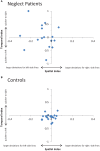Disentangling input and output-related components of spatial neglect
- PMID: 22707937
- PMCID: PMC3374575
- DOI: 10.3389/fnhum.2012.00176
Disentangling input and output-related components of spatial neglect
Abstract
Spatial neglect is a heterogeneous disorder with a multitude of manifestations and subtypes. Common clinical paper and pencil neglect tests fail to differentiate between these subtypes. For example, neglect patients typically bisect lines to the right. This bias can be caused by an underestimation of the left half of the line (input-related deficit), by the failure to direct actions toward the left side of space (output-related deficit), or by a mixture of these impairments. To disentangle these impairments, we used a test consisting of a line bisection task on a touch screen monitor (manual motor task) and the subsequent judgment of one's own bisection performance (visual perceptual task). It was hypothesized that patients with mainly output-related neglect should be better able to recognize their misbisected lines than patients with purely input-related neglect. In a group of 16 patients suffering from spatial neglect after right brain damage, we found that patients were three times more likely to suffer from a predominantly input-related than from an output-related subtype. The results thus suggest that neglect is typically an input-related impairment. Additional analysis of the line bisection task revealed that temporal (slowness in initiation and execution of contralateral movements) and spatial (insufficient movement amplitude toward the contralesional side) aspects of output-related neglect were mutually unrelated. This independence raises the possibility that a fine-grained differentiation of output-related neglect is required. That is, impairments in lateralized temporal and spatial aspects of movements may underlie different neglect subtypes.
Keywords: attention; motor neglect; neglect subtype; perceptual neglect; proof of concept; rehabilitation; spatial neglect; stroke.
Figures




Similar articles
-
Right hemispatial ipsilesional neglect with chronic right hemisphere strokes.J Clin Exp Neuropsychol. 2018 May;40(4):347-356. doi: 10.1080/13803395.2017.1347606. Epub 2017 Aug 16. J Clin Exp Neuropsychol. 2018. PMID: 28812421
-
Cingulate neglect in humans: disruption of contralesional reward learning in right brain damage.Cortex. 2015 Jan;62:73-88. doi: 10.1016/j.cortex.2014.08.008. Epub 2014 Aug 27. Cortex. 2015. PMID: 25239855
-
Disturbed line bisection is associated with posterior brain lesions.Brain Res. 2006 Mar 29;1080(1):17-25. doi: 10.1016/j.brainres.2004.10.071. Epub 2006 Mar 7. Brain Res. 2006. PMID: 16519881
-
Unilateral spatial neglect after posterior parietal damage.Handb Clin Neurol. 2018;151:287-312. doi: 10.1016/B978-0-444-63622-5.00014-0. Handb Clin Neurol. 2018. PMID: 29519463 Review.
-
The contribution of spatial remapping impairments to unilateral visual neglect.Neurosci Biobehav Rev. 2004 Apr;28(2):181-200. doi: 10.1016/j.neubiorev.2004.03.003. Neurosci Biobehav Rev. 2004. PMID: 15172763 Review.
Cited by
-
Prism adaptation theory in unilateral neglect: motor and perceptual components.Front Hum Neurosci. 2013 Nov 5;7:728. doi: 10.3389/fnhum.2013.00728. eCollection 2013. Front Hum Neurosci. 2013. PMID: 24204338 Free PMC article. No abstract available.
-
Spatial and non-spatial aspects of neglect.Front Hum Neurosci. 2013 Feb 5;7:25. doi: 10.3389/fnhum.2013.00025. eCollection 2013. Front Hum Neurosci. 2013. PMID: 23386825 Free PMC article. No abstract available.
-
The Importance of Lateral Connections in the Parietal Cortex for Generating Motor Plans.PLoS One. 2015 Aug 7;10(8):e0134669. doi: 10.1371/journal.pone.0134669. eCollection 2015. PLoS One. 2015. PMID: 26252871 Free PMC article.
-
Update on the Clinical Approach to Spatial Neglect.Curr Neurol Neurosci Rep. 2019 Apr 4;19(5):25. doi: 10.1007/s11910-019-0940-0. Curr Neurol Neurosci Rep. 2019. PMID: 30949868 Free PMC article. Review.
References
-
- Azouvi P., Samuel C., Louis-Dreyfus A., Bernati T., Bartolomeo P., Beis J. M., Chokron S., Leclercq M., Marchal F., Martin Y., de Montety G., Olivier S., Perennou D., Pradat-Diehl P., Prairial C., Rode G., Sieroff E., Wiart L., Rousseaux M. (2002). Sensitivity of clinical and behavioural tests of spatial neglect after right hemisphere stroke. J. Neurol. Neurosurg. Psychiatry 73, 160–166 10.1136/jnnp.73.2.160 - DOI - PMC - PubMed
-
- Barrett A. M., Burkholder S. (2006). Monocular patching in subjects with right-hemisphere stroke affects perceptual-attentional bias. J. Rehabil. Res. Dev. 43, 337–345 - PubMed
LinkOut - more resources
Full Text Sources

